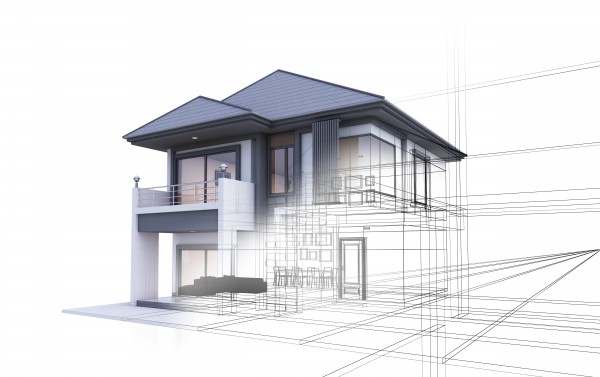Eight hacks to reduce the cost of your Self-Build
We all like to browse the discount aisle to save a penny or two, but when it comes to a self-build project, reducing the cost can be a game-changer. In 2018 the total number of completed self-builds reached a whopping 165,090, and the dream of building your own home is becoming more and more accessible each year. However, creating a realistic budget for such a big project can be a daunting process. So, for anyone thinking about starting a self-build project, we’ve accumulated some of the best hacks to reduce the cost of your self-build.
Maintain a Simple Design
Simplicity can save you money across every stage of a self-build, and a simple design plan can be the first step towards cutting costs. A square or rectangular floor plan, for example, can save you a lot of time in the ‘blueprint’ stage (especially if in collaboration with an architect), as well as later stages such as labour.
Labour is actually one of the most expensive parts of a build, so having a simplistic design can greatly reduce this costly process. Other ideas include an open plan design for daylight and sociable living, and simple geometry such as Georgian-style houses because of their elegant yet simple box-shape designs.
Hear from Gareth Boyd, Director at 2020 Architects, on 5 easy design changes that could save you money.
Learn more about how to design your self-build here.

Choose Your Location Wisely
Building a house that is visually appealing and is in keeping with the area around it will usually be more inclined to receive planning permission. And with respect to finding the right plot, there are certain factors to look out for that can save you a few pennies.
- Check that you don’t have to dig deep into your budget to connect to utilities because of a rural location
- If using solar panels, make sure your build receives sunlight throughout the day (find out more about renewable energy sources for self-build here)
- Even consider demolishing a property to create your self-build as salvageable materials can be sold on
By taking some time to thoroughly research your location, you can better understand what factors work best for you. And by making educated decisions allows for reduced costs when finding a plot. You can even talk to the locals around your respective plot to hear their opinions of the surrounding area.
Discover how to find the perfect plot here.

Modular Building
A modular home consists of repeated sections called ‘modules’. These sections are generally pre-built in an alternative location and then transported on flatbed trucks to the site for installation. This type of building method can save an inordinate amount of time and allows the building and site work to proceed simultaneously. Other benefits include an environmentally friendly construction process, low wastage, cost-effective materials, and the simplicity of connecting blocks provides freedom to the design through a variety of configurations.
Upcycle
The concept of upcycling can be utilised across all material and design decisions. When focusing on the construction process, upcycling a space such as a shipping container can be a very cost-effective option. All is needed is transportation and afterwards, your creativity can run wild to transform this container into a living space. Other ideas include upcycled furniture such as using a door as a bed headboard, or salvaging used materials from a dump or even setting your goals high by aiming to use upcycled objects for all interior design decisions.
Find out more about recycling materials in our blog five ways to reduce waste on your self-build.
Architects Aren’t the Only Option
Working with an architect can help you to save time, money, and a lot of stress. However, there are alternative professionals who might be able to provide an educated decision with reduced costs. Sharing your ideas with an architectural technologist, or a skilled house designer, or even a quantity surveyor can sometimes help to save a lot of money. This is obviously dependant on how abstract your ideas may be because an architect may be the best-qualified option for a creatively unique build.
Read our blog on three ways the right architect could help save you money to learn more.
Explore the things to consider when working with an architect here.

Think Renewable Energy
A property that is focussed on renewable energy can help to save future costs and eventually provide a return on the initial building costs. This hack requires some rather forward-thinking, but in respect to reducing costs, it will generate savings over time. The use of solar panels is always a great first step, while the idea of solar panelled roof tiles seems to be a rapidly growing trend. Other renewable options include heat pumps and even creating a smart home. The installation of an automated smart home system allows for quality monitoring and more control over the building’s functions.
Find out more about self-build options for renewable energy in our blog here.
Use Roof Space
By avoiding the use of a loft as storage and converting the roof into a living space allows you to have more for your money. Roof rooms will usually come at a much lower build cost/m² as you are sharing the same foundation cost as the other rooms. And in theory, the roof is going to be part of the build anyway, so why not use it? For example, installing Pasquill roof trusses in the initial build make it much easier and cheaper to convert a loft space at a later date. This build decision will save you spending more on an extra room and allows for more available space across the self-build.
The type of roof trusses that you choose for your self-build can have an impact on the way that you are able to use your roof space - only certain types can bear weight or allow for a loft conversion. Learn more about which type of roof truss is best for your self-build in our blog.
Learn more about the best type of roof for a loft conversion in our handy roof shape guide here.

Learn & Educate
This may seem like a no-brainer but giving yourself ample time to really understand the concept of your self-build can be an invaluable choice. And there are a number of ways to do so; you can go to self-build shows for inspiration and ideas, sign-up to a self-build magazine, and even utilise the social media community of other self-builders. When it comes down to the important budget organisation, an educated decision can save an inordinate amount of money.
Our website holds plenty of valuable information for self-builders to make an informed design about the design and materials for their self-build. Explore the website here.
A Self-Build project on a tight budget is definitely possible. One of the main cost saving aspects is keeping a simple or more modular design in the construction stage allowing you to save money on labour.


Can I Afford to Self-Build?
Although there is not one definitive answer to how much a typical self-build costs, our blog can help you evaluate whether you can afford to build – this is the first step in making your self-build journey a reality.

How Should I Design My Self-Build?
Our handy guide will ensure that you take the right steps to ensure your design vision becomes a reality.